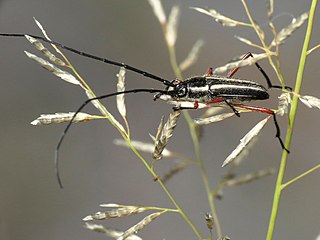
Agkistrodon is a genus of pit vipers commonly known as American moccasins. The genus is endemic to North America, ranging from the Southern United States to northern Costa Rica. Eight species are currently recognized, all of them monotypic and closely related. Common names include: cottonmouths, copperheads, and cantils.

The double-lined mackerel, is a species of Spanish mackerel in the family Scombridae. This species is sometimes also called the scad mackerel.

Agkistrodon bilineatus is a highly venomous pit viper species found in Mexico and Central America as far south as Honduras.
Causus bilineatus is a viper species endemic to south central Africa. No subspecies are currently recognized. Common names include lined night adder, two-lined night adder, and two-striped night adder. Like all other vipers, it is venomous.

Bahius is a genus of frog in the family Strabomantidae. It contains a single species, Bahius bilineatus, commonly called the Two-lined robber frog.

The yellow-rumped tinkerbird is a bird species in the family Lybiidae, which is native to the moist tropical and subtropical regions of sub-Saharan Africa.

Graphoderus bilineatus is a species of beetle in family Dytiscidae. The IUCN Red List reports it from Austria, Belgium, Bosnia and Herzegovina, Croatia, the Czech Republic, Denmark, Finland, France, Germany, Hungary, Italy, Latvia, Lithuania, Luxembourg, the Netherlands, Norway, Poland, Russia, Serbia and Montenegro, Slovakia, Switzerland, Turkmenistan, Ukraine, and the United Kingdom.
Agkistrodon howardgloydi is a species of venomous snake, a pit viper in the subfamily Crotalinae of the family Viperidae. The species is endemic to Central America. It is most commonly called castellana, but it has also been called the southern cantil, Gloyd's moccasin, and a number of other colloquial names. It is a rare species with a relatively small geographic distribution in the tropical dry forest on the Pacific coast of Honduras, Nicaragua, and extreme northwest Costa Rica. A. howardgloydi is a stout, medium-sized snake with a maximum total length of 96 cm (38 in). It is a viviparous species, with females giving birth in the rainy season from May to August. No clinical reports on envenomation had been published, but laboratory texts and analysis indicate the venom is highly toxic and similar to its close relative Agkistrodon bilineatus, and potentially lethal.

Bothrops bilineatus smaragdinus is a venomous pitviper subspecies found in the northern and western Amazon region of South America.

Cynoglossus quadrilineatus, the fourlined tonguesole, is a species of tonguefish native to the Indian Ocean from Pakistan to the western Pacific Ocean where it occurs from Japan to northern Australia. It can be found in marine and brackish waters in estuaries and coastal waters out to the continental shelf at depths of from 10 to 400 metres. This species can reach a length of 44 centimetres (17 in) SL though most do not exceed 30 centimetres (12 in) SL. It is important in local commercial fisheries.

Grammatorcynus is a genus of ray-finned bony fish in the family Scombridae. This genus together with Acanthocybium and Scomberomorus are comprised by the tribe Scomberomorini, commonly known as the Spanish mackerels or seerfishes.
Praealticus bilineatus is a species of combtooth blenny found in coral reefs in the western Pacific Ocean.
In the 10th edition of Systema Naturae, Carl Linnaeus classified the arthropods, including insects, arachnids and crustaceans, among his class "Insecta". Insects with net-veined wings were brought together under the name Neuroptera.

Coptobrycon bilineatus is a species of characin endemic to Brazil, where it is found in the upper Tietê River basin. It is the only member of its genus. It is found in freshwater environments at benthopelagic depths. This species is native to a tropical climate.
The flagtail wormfish is a species of wormfish native to the Pacific coast of the Americas from Mexico to Colombia as well as the Galápagos Islands. It is an inhabitant of tide pools and reefs being found down to a depth of about 8 metres (26 ft). This species grows to a length of 6.2 centimetres (2.4 in) SL. This species is the only known member of its genus. The generic name is a compound noun made up of the surname Clark, to honour the American ichthyologist H. Walton Clark (1870-1941) who described the species and ichthys the Greek for "fish".

Gnathodus is an extinct conodont genus in the family Idiognathodontidae.
Indolestes bilineatus is a species of spreadwing in the damselfly family Lestidae.

Sphaenothecus bilineatus, the double-banded bycid, is a species of long-horned beetle in the family Cerambycidae.

Agrilus bilineatus, the two-lined chestnut borer, is a species of metallic wood-boring beetle in the family Buprestidae. It is native to North America, and has been introduced to Turkey.

Athripsodes is a genus of insects in the family Leptoceridae.














